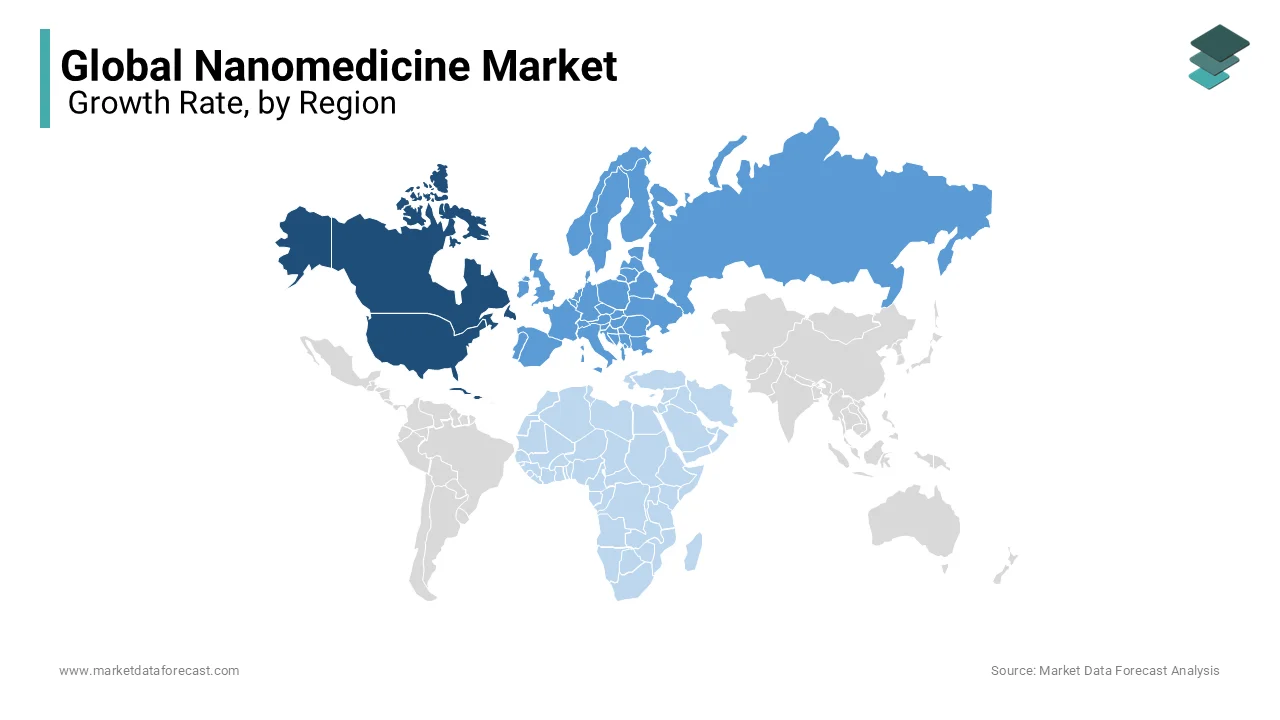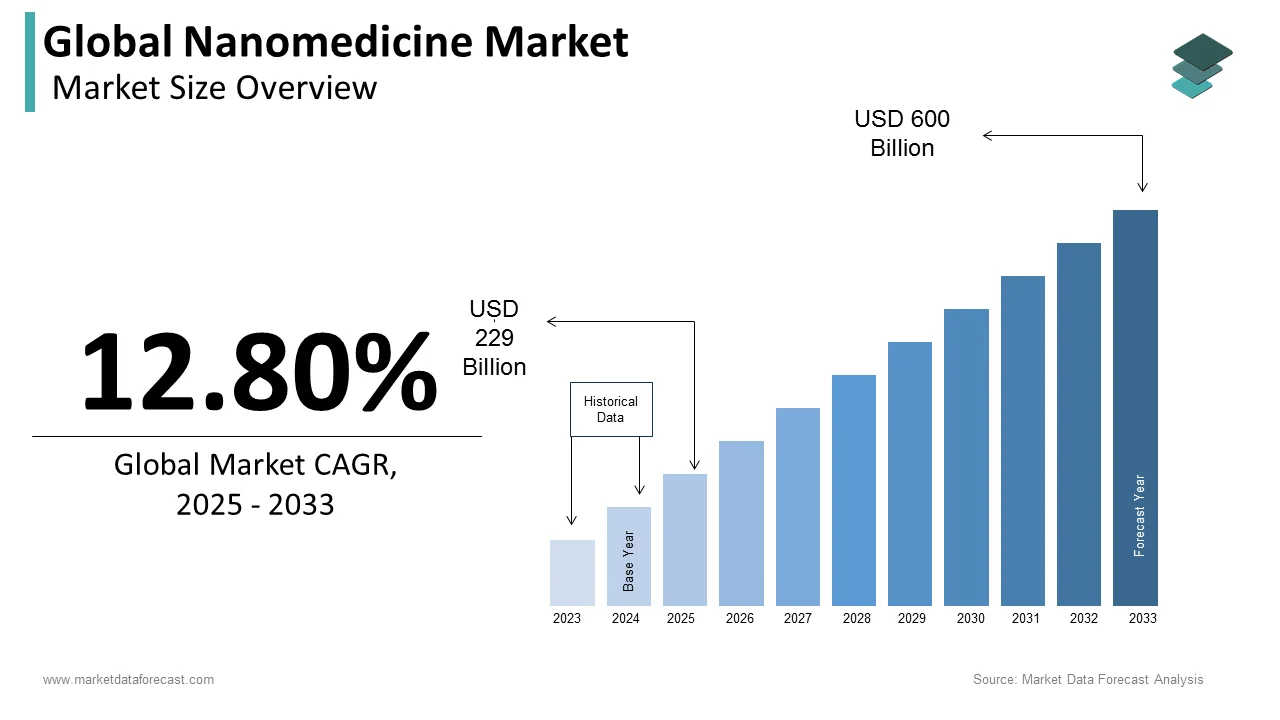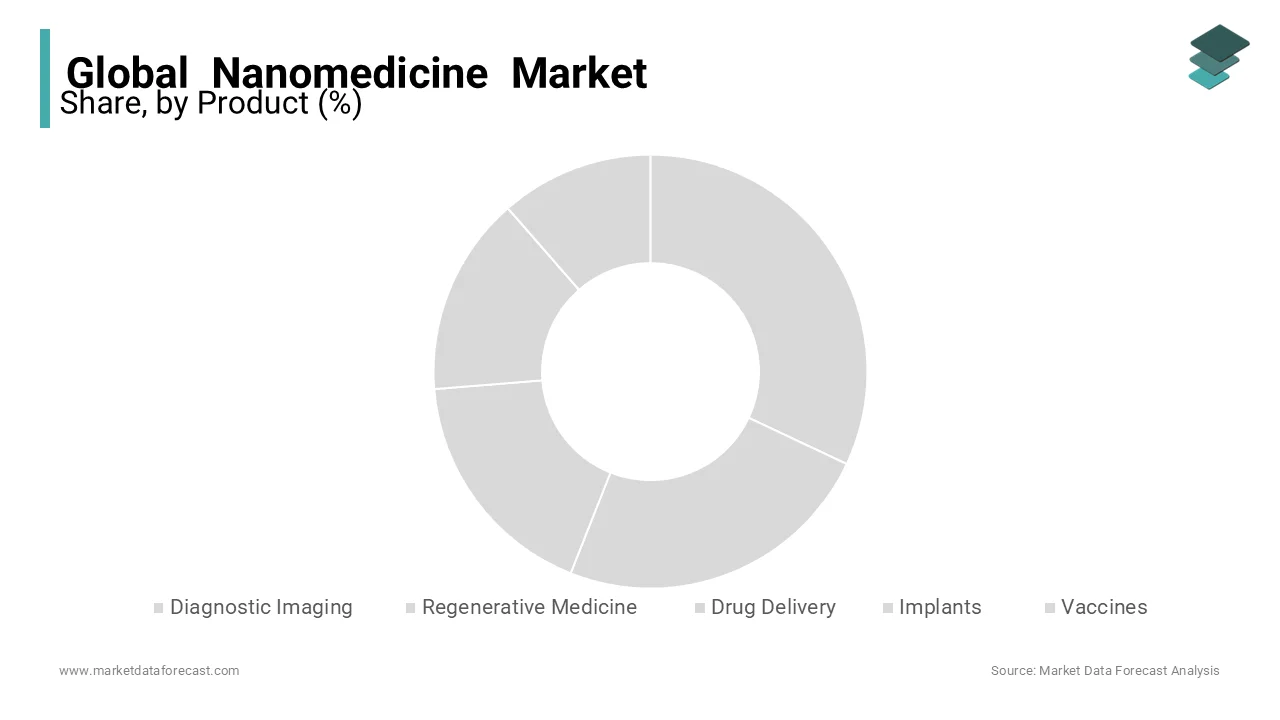Global Nanomedicine Market Size, Share, Trends & Growth Forecast Report By Product (Diagnostic Imaging, Regenerative Medicine, Drug Delivery, Implants, Vaccines and Others), Disease Type (Cardiovascular Diseases, Neurological Diseases, Ophthalmological Diseases, Infectious Diseases, Immunological Diseases, Orthopedic Disorders, Oncological Diseases and Others), Nano molecule Type and Region (North America, Europe, Asia-Pacific, Latin America, Middle East and Africa), Industry Analysis From 2025 To 2033.
Global Nanomedicine Market Size
The size of the global nanomedicine market was worth USD 203 billion in 2024. The global market is anticipated to grow at a CAGR of 12.80% from 2024 to 2033 and be worth USD 600 billion by 2033 from USD 229 billion in 2025.
MARKET DRIVERS
Increasing the acquisition of nanomedicine across various applications propels the growth of the global nanomedicine market.
In addition, the growing government support and funds and the rising need for requirements for a few therapies are driving the market's market growth over the period. In addition, research and development related to the medical field in manufacturing novel drugs for diseases influence the Nano-medicine market growth. Furthermore, growing applications of nanomaterials such as nanocapsules and nanotubes in drug delivery systems, a growing number of cancer and cardiovascular diseases, increasing public and private investments in research activities in Nanomedicine, and advancements in the biodegradable nanoparticles are the significant factors propelling the growth of the Nanomedicine Market. Applications of nanocapsules in drug delivery have shown excellent results in chemotherapy. Nanomedicine enables excellent precision in diagnostics and therapeutics, which was impossible before. Pipeline products being developed to target cancerous tumors are expected to boost the Nanomedicine Market.
MARKET RESTRAINTS
Unfavorable approval processes, the possibility of unintended risks during therapies, and the high cost of treatment using nanomedicine are hindering growth in the global nanomedicine market. One of the significant challenges for nanoparticle use in medicine is making the materials biocompatible.
REPORT COVERAGE
|
REPORT METRIC |
DETAILS |
|
Market Size Available |
2024 to 2033 |
|
Base Year |
2024 |
|
Forecast Period |
2025 to 2033 |
|
Segments Covered |
By Product, Disease Type, Nano-molecule Type, and Region. |
|
Various Analyses Covered |
Global, Regional & Country Level Analysis, Segment-Level Analysis; DROC, PESTLE Analysis, Porter's Five Forces Analysis, Competitive Landscape, Analyst Overview of Investment Opportunities |
|
Regions Covered |
North America, Europe, APAC, Latin America, Middle East & Africa |
|
Market Leader Profiled |
Johnson & Johnson, Merck & Co, Pfizer, Abbott Laboratories, GE Healthcare, Celgene Corporation, Nanosphere, Inc., Gilead Sciences, Hoffmann-La Roche, Nanospectra Biosciences, and Arrowhead Pharmaceuticals., and Others. |
SEGMENTAL ANALYSIS
By Product
Based on product type, the drug delivery products segment is predicted to account for the largest share in the global nanomedicine market during the forecast period due to the incredible precision with which drugs are delivered to the target cells or tissues in the body.
By Disease Type
Based on disease type, the oncological diseases segment is projected to dominate the global nanomedicine market from 2024 to 2033. This is because most of the research on Nanomedicine focuses on developing cancer treatment products.
The cardiovascular diseases segment is considered to have quick progress with the highest CAGR of nearly 11.7% during the review period due to changes such as demand for specific therapeutic Nano-vectors, Nano-structured stents, and implants for tissue regeneration to accelerate the Nano-medicine market growth.
By Nano Molecule Type
Based on the Nano-molecule type analysis, the Nano-Particles segment is leading the Nano-medicine market growth. It is attributed to factors such as using these Nano-particles for active targeting by binding to ligands of a cell receptor, which is an essential tool for Nano-medicine and Nano-technology. These Nano-particles contain metal and metal oxide particles that influence market growth over the review period. Research and developments carried out for theranostics are expected to drive the market.
REGIONAL ANALYSIS
Geographically, the North American nanomedicine market is predicted to lead the global nanomedicine market during the forecast period due to the enormous investments in research in Nanomedicine from government organizations in the United States. This region's growth is attributed to the increasing existence of patented Nano-medicine products. The US is leading the Nanomedicine of the region due to considerable investments in market research from government organizations. In addition, to the developed healthcare infrastructure and high cancer occurrence, Nanomedicine is readily obtained in this region.

The nano-medicine market in the European region is considered to have produced profitable outcomes over the upcoming years, which owes to the increasing burden and focus on advanced technologies in the market over the period. In addition, this region has many significant companies in Nanomedicine, which results in high proliferation and sound knowledge among people. The UK is the leading country in the Nano-medicine market in this region. A wide range of Nano-medicine applications such as Nano-capsules and Nanotubes in drug delivery systems may assist the UK market to grow high.
The Asia Pacific is expected to be the fastest-growing market due to the high incidences of cancer and cardiovascular diseases owing to a large senior population. In addition, a growing number of research grants and an increasing demand for life-threatening diseases are accelerating the market growth in the Asia Pacific. Older people's population growth in the Asia-Pacific region is contributing to the market growth in APAC. China leads the market of this region due to the growing occurrence rate of cancer and cardiovascular diseases boosting the market growth. Japan is said to be the most attractive destination of the period.
The Latin American market is predicted to grow steadily over the analysis period. The growth of this region owes to increasing public and private organizations' investments in research activities in Nanomedicine, and advancements in biodegradable Nanoparticles are the factors fuelling the market growth. Brazil is accounted for having a significant share and leading the market of this region. Factors like developing the healthcare sector contribute to this country's growth, and growing government investments are driving the growth in this region.
The Middle East & Africa has the least share in the global nanomedicine market over the forecast period. Factors like significant funds and investments in clinical trials by the government and private sectors lead the market growth. In addition, the market growth is due to the high adoption rate in countries like Israel and Dubai.
KEY MARKET PARTICIPANTS
A few of the most dominating players in the global nanomedicine market profiled in this report are Johnson & Johnson, Merck & Co, Pfizer, Abbott Laboratories, GE Healthcare, Celgene Corporation, Nanosphere, Inc., Gilead Sciences, Hoffmann-La Roche, Nanospectra Biosciences, and Arrowhead Pharmaceuticals.
RECENT MARKET DEVELOPMENTS
On March 05, 2019, Pfizer issued a license for AnTOIRx’s immune tolerance for autoimmune illnesses, including rheumatoid arthritis, inflammatory bowel diseases, psoriasis, multiple sclerosis, and Type-1 diabetes. In addition, the technology is designed to bring immune tolerance to specific self-antigens in diabetes.
MARKET SEGMENTATION
This market research report on the global nanomedicine market has been segmented and sub-segmented based on the product, disease, nano-molecule, and region.
By Product
- Diagnostic Imaging
- Regenerative Medicine
- Drug Delivery
- Implants
- Vaccines
- Others
By Disease Type
- Cardiovascular Diseases
- Neurological Diseases
- Ophthalmological Diseases
- Infectious Diseases
- Immunological Diseases
- Orthopedic Disorders
- Oncological Diseases
- Others
By Nano Molecule Type
- Nanotubes
- Nanoparticles
- Nanodevices
- Nanoshells
- Others
By Region
- North America
- Europe
- Asia-Pacific
- Latin America
- The Middle East and Africa
Frequently Asked Questions
What is the current size of the nanomedicine market?
The global nanomedicine market was worth USD 203 billion in 2024.
Who are the key players in the nanomedicine market?
Johnson & Johnson, Merck & Co, Pfizer, Abbott Laboratories, GE Healthcare, Celgene Corporation, Nanosphere, Inc., Gilead Sciences, Hoffmann-La Roche, Nanospectra Biosciences, and Arrowhead Pharmaceuticals are some of the notable players in the worldwide nanomedicine market.
What are the drivers of the nanomedicine market?
The growing prevalence of chronic diseases, the growing aging population, and the demand for personalized medicine are majorly boosting the growth of the nanomedicine market.
What are the challenges facing the nanomedicine market?
The high cost of research and development, regulatory hurdles, and the need for more clinical trials to demonstrate safety and efficacy are some of the key challenges to the growth of the nanomedicine market.
Related Reports
Access the study in MULTIPLE FORMATS
Purchase options starting from $ 2500
Didn’t find what you’re looking for?
TALK TO OUR ANALYST TEAM
Need something within your budget?
NO WORRIES! WE GOT YOU COVERED!
Call us on: +1 888 702 9696 (U.S Toll Free)
Write to us: [email protected]


